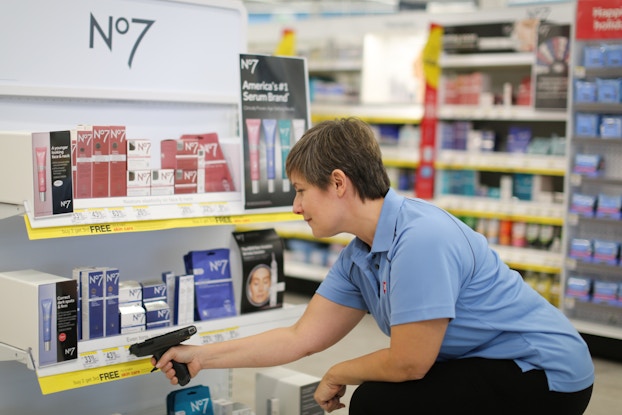
Via a series of wide-ranging partnerships, Walgreens has been working to unlock the brand equity of other brands — from Kroger’s grocery chops to FedEx’s delivery prowess and Birchbox’s indie beauty sheen — to woo new shoppers, fend off heightened competition and boost sales.
Now it’s turning to mobile technology tools to help pull that all off.
But girding new partnerships is just one piece of a larger goal. Walgreens’ tech upgrade, which is expected to be completed in summer 2020, aims to resolve a disconnect: The retailer’s outdated store systems were a mismatch for the heightened expectations of today’s digitally-rewired consumers — those Amazon Prime-addicted, Uber-hailing, Netflix-streaming shoppers who want what they want when they want it like never before.
Walgreens’ eight million shoppers are no different, yet its inventory management tools were falling short in meeting their demands, Andrea Farris, vice president of special projects for Walgreens, told CO—. “Customers were disappointed coming in and not finding what they were looking for,” he said. “And it was a cumbersome process for team members to order items for a customer and to make sure the inventory was accurate.”
The feedback from stores came in two ways, he said. “Our team members were having to spend time across multiple systems to leave the customer’s side to provide that information, and customers were leaving the store without finding what they were looking for and without buying.”
The performance shortfall called for a chain-wide shift to data-driven mobile solutions for faster and more accurate merchandise tracking, and assisted-selling tools that answer shoppers’ in-the-moment needs, from locating an item for home delivery to empowering Walgreens’ beauty consultants with rich content for an in-store makeover.
The digital makeover unfolding at the 9,560-store retailer is designed to serve consumers who now shop seamlessly between mobile, desktop and physical shopping channels and are often savvier about the products they’re buying than the sales associates selling them.
It comes as the big established merchants scramble to transform what had once been considered a liability in competing against online retailers (unencumbered by store operating costs) into an asset: their physical stores, which in Walgreens’ case are accessible to 78% of the U.S. population.
The minute you walk away from a customer, you risk losing a sale. The customer can decide to purchase at another time or another retailer.
Andrea Farris, VP of Special Projects, Walgreens
“Brick-and-mortar retailing today is all about relevance, and Walgreens’ recent efforts appear aimed at improving on this critical dimension. If you can’t meet digital-first shoppers’ need for speed, the next best transaction is always just a click away,” Andrew Lipsman, principal analyst for eMarketer, told CO—.
“Integrating real-time digital experiences into the store and giving customers more reasons to drop by in the first place should better position Walgreens to compete in the age of Amazon.”
Upgrading the unsexy-yet-critical cog of retail to save the sale
Across Walgreens’ store fleet, siloed inventory management systems with limited functionality made it difficult for store teams to locate products and set up merchandise displays quickly and efficiently, stymying worker productivity and eating into time that could be spent serving shoppers.
The challenge was that a patchwork of legacy devices made critical store-associate tasks, like locating an item for a shopper, arduous and inefficient, imperiling sales and customer service.
If a shopper can’t find what they want on a store shelf, they’ll often nix the purchase, or split and buy it from a competitor — and that’s never been truer than today as an endless aisle of choice awaits them online.
Indeed, out of stocks cost retailers worldwide a whopping $984 billion in missed sales, including $145 billion in North America alone, according to IHL Group.
Inventory management, knowing where an item is at any given moment in a retailer’s supply chain, is the unsexy-but-critical merchandising discipline that has become infinitely more complex in a multichannel shopping landscape. That comes as shopper demands for a bevy of convenience options — from buy online, pick up in store to curbside pick-up — are mounting.
For its part, Walgreens is exploring more ways for customers to access its products, Farris said, from next-day delivery for pharmacy prescriptions to BOPIS (buy online pick up in store). BOPIS, or click-and-collect, is now available in all Walgreens stores and has reached a percentage of sales in the double digits, although the retailer declined to disclose that figure.
But more tech-enabled convenience also invites more ways to disappoint consumers by failing to deliver a frictionless, omnichannel shopping experience.
In Walgreens’ case, a “dis-integrated” inventory management system, with functions split between outmoded mobile devices and a backroom PC, clouded inventory visibility: If a worker on the sales floor wanted to check to see if a missing item was available for a customer at a nearby location, they couldn’t do so on the device, nor could they direct it to ship the out-of-stock item to a shopper’s home, nor could they access an online order.
Instead, workers were forced to trek to a back-office PC to retrieve that information, leaving shoppers waiting — precious time that often results in lost sales and compromised shopper goodwill. “The minute you walk away from a customer, you risk losing a sale,” Farris said. “The customer can decide to purchase at another time or another retailer.”
To retrofit its stores with technology befitting a changed shopping environment, Walgreens began the transition from the siloed systems to business intelligence handheld computers and tablets from Zebra Technologies.
The phase-in of these mobile solutions is starting to bring real-time inventory visibility to Walgreens store associates. The device’s My Inventory app, for example, can determine an item’s precise location — whether it’s on site or sitting in a truck en route to a store.
From the handheld device, sales associates in upgraded stores can now order a missing product on the spot, fulfill click-and-collect orders — all without leaving the shopper’s side, “and that’s a key way to maximize a sale opportunity,” Farris said. “Now, information and service applications are available at their fingertips,” from a single, nimble, mobile platform, he said. “We’ll see fewer missed sales and higher customer satisfaction because they’re finding what they came in looking for.”

Streamlining brand partnerships from Kroger to FedEx
Walgreens expects the mobile platform to buoy its pilot with Kroger, which is designed to differentiate the retailer’s product mix from competing drugstore chains with groceries from an established supermarket player.
For now, shoppers can order select groceries on Kroger.com, like its Home Chef Meal Kits and Simple Truth organic house brand, and pick up their items at 13 pilot Walgreens locations in Kentucky, near Kroger’s Cincinnati headquarters. It’s also offering click-and-collect on grocery items via the Kroger pilot.
Farris anticipates that, with the potential expansion of the Walgreens/Kroger partnership, “inventory management [on the mobile platform] for these items, which have a high velocity, will become even more important,” he said.
The retailer is also banking on the mobile platform to streamline its collaboration with FedEx, whereby shoppers can pick up and drop off their FedEx packages at 8,000 Walgreens stores across the country. Walgreens is angling to capture shopper traffic from the surge in deliveries from online orders, while offering a solution to rising consumer concern over the security of a package left on a front porch, for example. (The retailer is finding that some shoppers are now directing their big-ticket purchases from diamond jewelry to an entire set of car tires to Walgreens’ FedEx hubs.)
And it’s hoping the partnering with FedEx will lead to add-on sales. “The return on investment is the [shopper] traffic in the stores and the potential of them buying an additional item,” Farris said.
Overall, Walgreens envisions a scenario whereby a shopper could pop in to pick up a package from FedEx at 7 p.m. on their way home, and also grab milk. But maybe the Walgreens is out of the diapers, shampoo or vitamins they need, so they ask a team member on the floor with the Zebra device to order the items for them and have them shipped to their home or the store — whatever’s easiest.
“The mobile platform allows Walgreens to develop solutions relevant to the partners that we bring in our stores,” he said.

Cultivating department store beauty services at discount prices
Meanwhile, Walgreens’ store associates were increasingly facing an emerging wave of experts that they were ill-equipped to meaningfully serve: the shoppers in its beauty aisles.
“It goes back to the fact that our customers are coming into the stores with a lot more information available to them than ever before,” Farris said. “They’ve done their research online — the store teams were at a disadvantage as the customer had more information [on the merchandise] than they did.”
For Walgreens, empowering store associates in beauty with information-rich mobile devices is critical to the beauty makeover afoot at the chain. The drugstore retailer has upgraded the beauty departments in 3,000 stores, staffing them with 3,500 beauty consultants, as it tests in-store shops from online subscription box service Birchbox in 12 stores. [Read more about Birchbox’s move into Walgreens’ retail stores.]
“We want to elevate the beauty experience beyond being a last-minute trip for mascara, to actually have beauty consultants, makeovers, and be set up like what you’d expect to find at a department store, without the department store prices,” Farris said.
But in order to be taken seriously as a credible arbiter of beauty trends, “Walgreens needed to upgrade the tools and solutions in our stores so that team members could meet the [beauty] customers’ expectations and provide better service,” he said. “Beauty becomes a fashion statement, and our beauty consultants need to be up to speed on the latest beauty trends.”
Today, Walgreens’ beauty consultants use the tablets as an assisted-selling tool, Farris said. They access information like detailed product descriptions, photos and curated content from vendor partners like L'Oréal, as well how-to videos and tutorials for makeovers. And from the tablet, “We can sign up customers in store for our Beauty Enthusiast loyalty program, and build a beauty profile for the customer to recommend specific products according to their attributes,” be it skin type, tone, hair color or makeup preferences, he said.
“Our goal is [shopper] convenience,” Farris said. “At the end of the day, you can talk about digital capabilities all you want, but if your inventory is not accurate and you disappoint customers, in this age, the customer is not coming back.”
CO— aims to bring you inspiration from leading respected experts. However, before making any business decision, you should consult a professional who can advise you based on your individual situation.
CO—is committed to helping you start, run and grow your small business. Learn more about the benefits of small business membership in the U.S. Chamber of Commerce, here.




